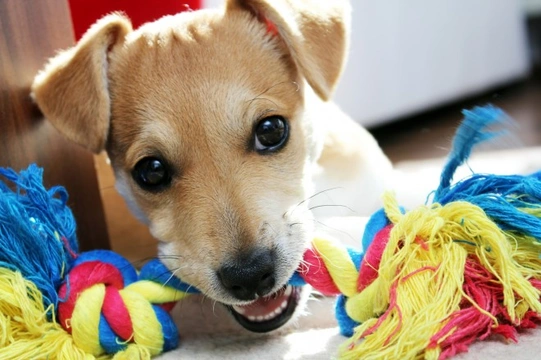
How to encourage a shy or quiet dog to play
Learning how to play and have fun is something that most puppies begin to pick up before they are even weaned from their dam, and usually, puppy owners need to spend a significant amount of time and energy keeping their pups from getting up to no good rather than encouraging them to take an interest in things! Socialisation and playing are important parts of canine development, and are skills that all dogs should actively enjoy and be willing to take part in.
However, for dogs that are very docile, shy or nervous, they may be reluctant or unwilling to play, or too fearful to be willing to have a go, or not even understand what playing is or why it is an enjoyable thing. If this is the case with your dog or puppy, the chances are that they are missing out on a whole host of important life lessons, as well as opportunities to have a good time and really let their hair down and have fun.
In this instance, it is important that you as the owner or handler of the dog work with your dog or pup to teach them about play, teach them how to go about it, and make it a positive and enjoyable experience for your dog. In this article, we will look at some of the different ways in which you can go about this.
Building your dog’s confidence and trust
If your dog trusts you, looks to you for guidance and is willing to step outside of their comfort zone to please you, you have a head start in being able to coax the reluctant dog into play.
This means that the first stage of encouraging your shy or nervy dog into a game is by building their trust in you, and reinforcing their sense of stability and confidence. Food is one of the best ways to do this, as even the most shy or nervous of dogs will usually show an interest in tasty treats and food, and you can use this to your advantage.
Start off with a food treat that is reasonably fragrant and that you know your dog enjoys, and hide the treat in your hand. Sit on the floor so that you are both accessible to your dog and not looming over them, and ignore the dog until they manage to pluck up the courage to come up to you and explore where the source of the delicious smelling treat is coming from.
When your dog does come up to you and either sniffs your hand for the treat or makes eye contact with you in request for the treat, let your dog have the treat and speak to them warmly with praise. This will, over time, build your dog’s confidence and trust in you, and you will be able to progress to patting your dog when they approach, and working on their boldness to approach you.
Encouraging your shy dog into a game
Once your dog has mastered the art of the active approach and the reward that comes with this, you can move on to other things.
Begin by repeating the tempting treat process, but while you are standing up. When your dog is ok with this, move on to walking slowly around within sight of your dog, with the treat hidden in your hand or pocket. Make your walking pace smooth and gentle enough that your dog does not find it alarming, but quick enough that your movement draws their interest and makes them want to get up and follow you. This will mean that your dog has to make the active decision to get up and follow you, drawing the dog into your game in a no-pressure situation that the dog can take or leave, at their own pace.
When your dog has followed you for a few steps, hand over the treat, again with a praising voice and lots of reassurance. Repeat this process several times over several days to a couple of weeks. Once your dog has got used to this and is confident in the process, accompany the treat with a toy.
Repeat the process as before, handing over both the treat and the toy to the dog, and over time, remove the treat from the equation entirely, handing over only a toy with no treats involved.
Once your dog comes to desire the toy for its own merits along with the praise that accompanies it, begin to keep hold of the toy for a few seconds before you release it to your dog. When your dog actively seeks out the toy, and attempts to take it in their mouths while it is in your hand, begin to gently tug on the toy, encouraging your dog to tug back, while keeping things gentle, low key and reassuring.
Ultimately, you should be able to maintain a low-level tug of war game with your dog, as their confidence builds. From this foundation, you can move on to other games and interactive play with your dog using a toy or a ball, providing that you take the whole process slowly and work at your dog’s own pace.



